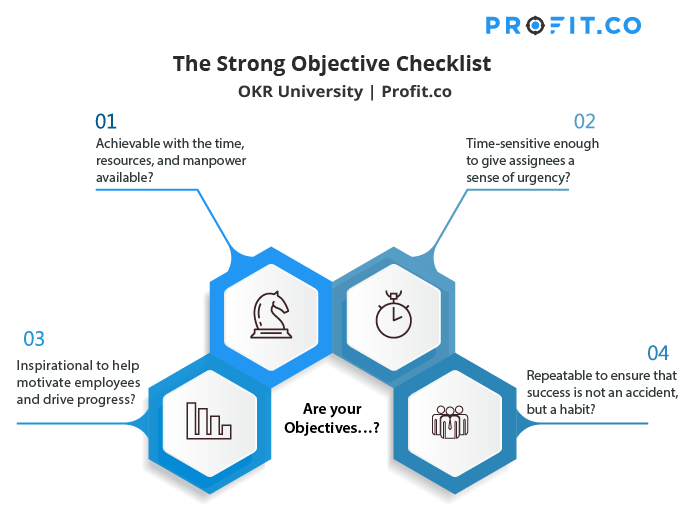A project manager has always been an integral part of most businesses that grow big enough to need a management system. Tasked with the oversight and execution of key strategies, it’s no longer enough for even the best project managers to rely on experience, delegation, and spreadsheet tracking.
Tend to the people, and they will tend to the business.
While these are all crucial elements, organizations in the digital age have simply become too complex to rely on them without adequate support. But in a project, the management is the support, so who supports them? More importantly: is an objective and key results (OKR) framework viable in project management?
The answer to the latter question is a resounding yes! The former needs to be broken down first.
What is an OKR framework?
What are OKRs? Simply put, an objectives and key results framework is about goal-setting and goal-getting. Of course, there’s a level of nuance and context that goes out the window when we simplify to that extent, but that’s the backbone of it. What surrounds that backbone depends on three factors:
- The company
- The problem that framework needs to solve
- The resources available to execute
Now, an OKR framework can be implemented even on a shoestring budget. Better yet, it’s an incredibly scalable strategy, meaning it has the potential to grow within an expanding structure and adapt to new needs as the company does.
That flexibility can be highly valuable to project managers, who always need to be able to pivot at a moment’s notice.
OKRs are divided into two sections: objectives and key results. These terms share an extremely close relationship, but they should also be understood individually.
An objective is an overall goal that a company is working towards. This is usually a long—term goal, set annually and usually defined as a company OKR at the corporate level or by relevant stakeholders. It’s a target that comes from the very top. However, in order for every other level in the organization to do its part in the execution, an objective needs to be paired with key results.
Key results are the processes, tasks, and practices that will need to be completed in order to reach the objective or achieve the goal. Think of key results as a “to-do list” for your most important outcomes and KPIs instead of tasks. Each item on that list is designed to get the organization as a whole a little closer to the objective that everyone is working towards.
Ready to manage tasks and OKRs on a sophisticated management software that’s still easy to use? You can get started on Profit.co completely free today!
How can OKRs benefit project management?
That’s a dynamic that will be familiar to many project managers. Indeed, one of the hardest things about project management is organizing tasks according to urgency and delegating the right ones to the teams in the best position to execute. That has to happen alongside balancing finite resources, optimizing the work in individual departments and keeping everyone on the same page.
Most projects also have to contend with linear processes, where crucial tasks have to be executed in sequential order. This can lead to slow execution when managers are unable to hone in on where the bottlenecks are. That’s where OKR comes in.
Within an organization, everyone who works on the project should understand the goal clearly. A good objective is four things:
- Achievable
- Time-sensitive
- Inspirational
- Repeatable

Achievable means setting a goal that can be reasonably achieved within a set (and known) timeframe. That means not setting a goal so ambitious that people are demotivated before they even start. Note that demotivation isn’t always about feeling like a task can’t be achieved. At a time where more workers are entering the office with generational levels of stress and burnout, demotivation can simply mean a task costing too much energy to reasonably complete.
On the flip side of that coin, an objective still needs to be inspirational. There should be a “consequence” to reaching an objective – a material benefit that everyone can hold onto when the work gets tough. When set correctly, OKRs can foster a high performance culture in your organization.
Unlike an objective, not everyone in a team needs to be responsible for every key result. That’s because there’s usually only one uniting objective, and so project managers can align those under them to it. There can be any number of key results because these are the outcomes that define how the objective is reached.
Key results can be developed using the SMART goal structure. This structure will give you a good idea about the qualities that you need to be able to see in each key result as you write it to ensure that you are setting actionable outcomes rather than tasks.
OKR as a management tool
Thanks to the relationship between an objective and its key results, OKR and remote performance tend to work well together. Employees who understand the overall objective and their individual tasks have the two pieces of information needed to operate with enough trust and autonomy to execute their work away from an office.
But what does this mean for companies? Well, it creates accessibility within a project, opening up opportunities to work with skilled people who otherwise wouldn’t be able to make it into the physical building. Even those with the means could avoid the time and energy cost of the daily commute.
Remote work also means office resources can be directed towards in-person functions. So individuals save on their personal resources, and companies save on organizational ones. As for project managers, the ability to supervise and offer support remotely means getting more done in less time and while maintaining a clear overview of the project throughout. OKRs can help remote performance in substantial ways- but it’s up to project managers to make this potential a reality.
Project performance and examples
The beauty of OKRs is that they’re applicable across business models and scales. The same framework can work for small, medium and large—scale companies. It also serves as the bridge when scaling up. But what does OKR in project management look like?
Let’s take a look at some development goals for project managers, with examples from a speculative media company and an e-commerce business.
Unlock YouTube live streaming function by the end of November to allow for live festive events in December
This is an effective objective for all the reasons listed above. It sets a goal that’s easy to understand and repeat to others within the organization. Crucially, there’s no measurable metric in that goal. YouTube requires a channel to have 1000 subscribers to unlock live streaming capabilities.
That number will fall under key results because those need to be measurable. This objective needs to tell people why they’re working and what they’re working towards
Increase revenue to cover the cost of next year’s spring collection
Note that, even in this example, we could include the dollar amount the company needs to earn. But not everyone within the project will be tasked with making sales – the dollar amount is information a marketing team and accounting would need, but not HR or the design team.
Final Thoughts
OKRs can be combined with project management skills to deliver results that are seamlessly aligned with the strategic goals of an organization. In order to properly utilize OKRs and get the most out of initiatives, leaders should take the time to learn the Objectives and Key Results framework, and curate OKRs that address their highest priorities within their organization.
To learn more about project management, strategy implementation, and OKRs, book a free demo with our OKR experts today!

